Are your floors showing the wear and tear of time, or perhaps you’ve just settled into a new residence and find yourself in a quandary over selecting the ideal flooring?
Revamping your entire floor surface or making choices about it can certainly present a formidable challenge.
But fret not! In this day and age, you’re spoiled for choice when it comes to flooring options.
So, there’s no need to grapple with indecision when picking the right flooring, and you can bid farewell to those worn-out floors of yesteryear.
However, it’s crucial to note that you shouldn’t make hasty decisions without careful consideration. The perfect flooring for one home might not suit another.
Several factors must be weighed, including the materials, environmental conditions, household needs, the occupants, not to mention the budget that requires prudent calculation.
This guide aims to assist you in embarking on a well-informed exploration of your flooring options. It also includes a comprehensive rundown of the pros and cons associated with the ten most commonly chosen types of flooring.
Hardwood
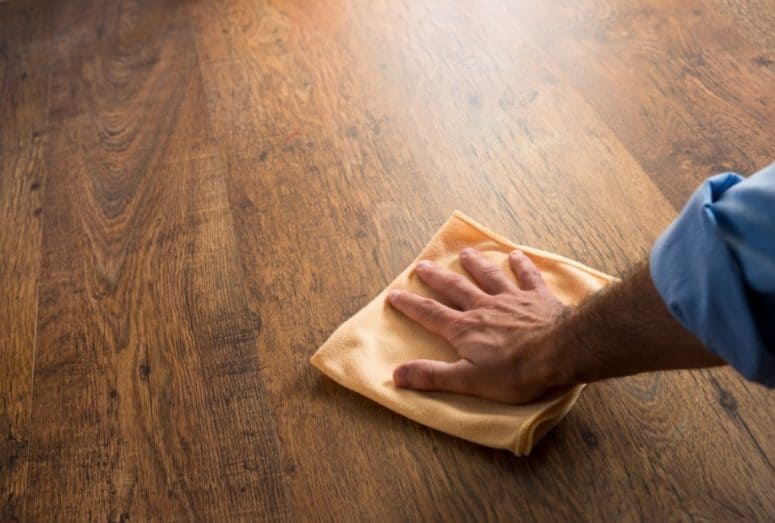
Hardwood flooring stands as a cherished choice, particularly in the United States, and is treasured for its genuine, solid wood construction, necessitating the meticulous process of nailing it to the floor.
Typically, it is available in either narrow strips, measuring up to 2.5 inches, or broader planks, extending up to 4 inches in width. Hardwood flooring derives its substance from solid wood varieties like walnut, oak, cherry, maple, and numerous others.
I’d strongly advise sourcing hardwood from companies bearing FSC (Forest Stewardship Council) or SFI (Sustainable Forestry Initiative) certification to ensure that the wood originates from legal and sustainable logging practices.
You have the option to order hardwood flooring in a finished or unfinished state. Opting for the unfinished variant entails sanding and finishing it yourself, which generally comes at a lower cost compared to the finished variety, boasting enhanced durability courtesy of professional finishing.
Pros:
- Hardwood enjoys immense popularity due to its aesthetic adaptability, effortlessly complementing various spaces within a home and radiating a warm, natural charm.
- Cleaning and maintaining hardwood floors is a breeze, resulting in a polished appearance that’s undeniably pleasing to the eye.
Cons:
- Hardwood flooring is sensitive to temperature fluctuations, prone to contraction when exposed to such conditions, leading to a less appealing appearance and diminished durability.
- Susceptible to scratches, hardwood can bear lasting marks from wear and tear.
- It’s advisable to avoid installing hardwood flooring in areas prone to moisture, like bathrooms or kitchens, as it’s not well-suited to such environments.
Bamboo

Bamboo ranks among the common materials employed in the realm of wooden flooring, and it bears an uncanny resemblance to hardwood in both appearance and texture.
However, the distinguishing feature lies in the grainy patterns inherent to bamboo grass.
Flat-grain bamboo manifests darker streaks across the boards, while vertical-grain bamboo exhibits narrow, string-like stripes tightly clustered together. End-grain bamboo, on the other hand, is characterized by its short, diminutive strips.
Pros:
- Bamboo possesses a remarkable growth rate, outpacing the likes of oak, maple, cherry, and other traditional hardwood sources. This rapid growth makes bamboo a more environmentally friendly option, given that the cultivation and harvesting of bamboo do not result in ecological imbalances.
Cons:
- Bamboo flooring boards, stripes, and planks are manufactured through the process of pressing bamboo and blending it with adhesive using advanced machinery. However, certain producers employ excessive amounts of formaldehyde-based adhesives, posing potential health risks.
- Furthermore, the extensive production of bamboo flooring leads to an elevated demand for pesticides in bamboo farming. While this practice is plausible, it undoubtedly raises concerns about its environmental impact.
Engineered Wood
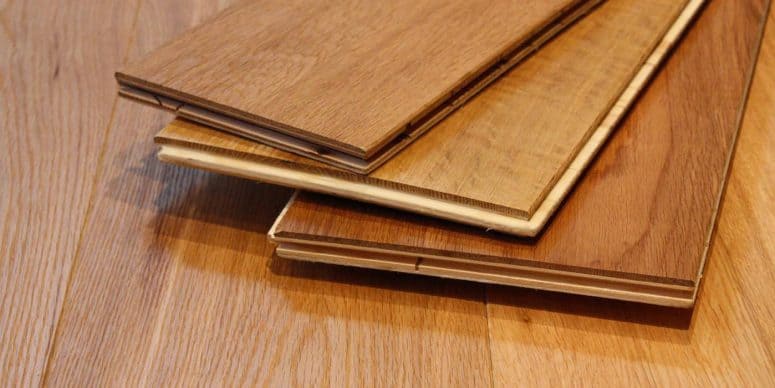
Engineered wood flooring bears an uncanny resemblance to hardwood flooring in terms of appearance.
But what sets it apart from traditional hardwood flooring?
The production process of engineered wood differs significantly. It features a real wood veneer on the surface, while the underlying layers consist of thinner plywood as opposed to solid hardwood, making it a cost-effective alternative.
Engineered wood also incorporates a tongue-and-groove system, facilitating a click-together installation, ideal for various applications.
The top veneer exudes the same warmth and visual appeal as genuine hardwood, rendering it a suitable choice for low-traffic spaces such as living rooms and bedrooms.
Pros:
- Engineered wood exhibits resilience against temperature fluctuations, offering versatility even in basement installations.
- Despite its striking resemblance to hardwood, engineered wood comes at a more affordable price point.
- The top veneer, tongue-and-groove system, enables a floating installation by simply interlocking the boards, affording flexibility. It can also be glued down instead of solely relying on nails.
Cons:
- Despite its versatility, engineered wood shares the same susceptibility to scratches and markings as solid wood.
- The ability to refinish the floor is limited, typically allowing only one to three refinishing cycles. Beyond this threshold, the wood veneer on top may wear out, revealing the thinner plywood layer beneath.
Considering these factors, engineered wood may not be the most durable flooring option in the long run. What are your thoughts on this matter?
Ceramic or Porcelain Tile
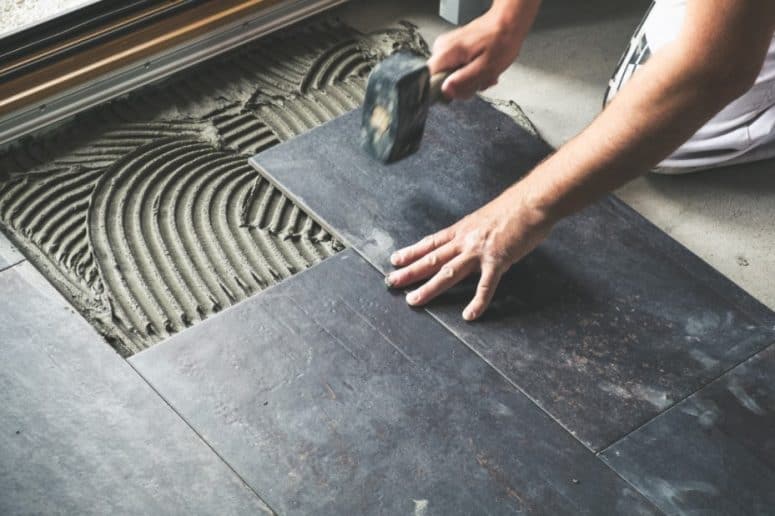
Ceramic and porcelain flooring options hold significant popularity, with ceramic being a personal favorite of mine. Ceramic primarily consists of clay and shale, rendering it exceptionally durable.
Moreover, ceramic flooring offers an extensive array of materials, sizes, and patterns. There’s the glazed variant, characterized by a glass-like surface that exudes a glossy appearance, available in a multitude of patterns and colors.
On the other hand, porcelain stands as one of the hardiest ceramic options, renowned for its solid construction and suitability for outdoor use. Additionally, quarry tile and terracotta tile, both unglazed varieties, offer enhanced slip resistance.
Pros:
- In comparison to wooden and laminate flooring, ceramic tiles demand the least maintenance, making them easy to clean. They come in a diverse range of colors, patterns, and even customizable designs.
- The availability of various sizes renders ceramic flooring highly versatile, accommodating a wide range of interior design styles.
Cons:
- Ceramic tiles, especially terracotta and quarry tile, can be prone to staining if not regularly sealed.
- Glazed ceramic tiles can be slippery when installed in areas like bathrooms and kitchens, and they may impart a cold sensation when walked or sat upon.
- The most robust ceramic option can be challenging to repair once it develops cracks or breaks.
Laminate
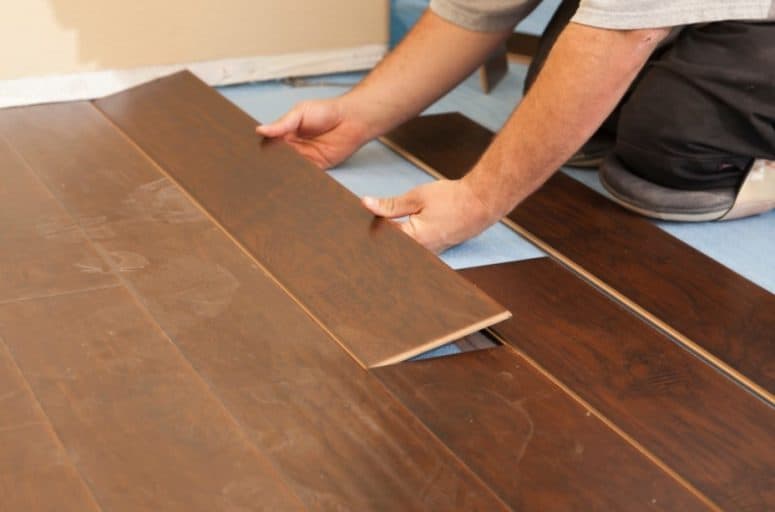
At first glance, it may deceive you into thinking it’s wood, but in reality, laminate flooring boasts a thin plastic veneer adorned with printed patterns on its surface. However, beneath this façade lies a foundation of plywood, similar to the construction of engineered wood.
The allure of laminate flooring lies in its modern design, eliminating the need for adhesives or nails for installation; it can be effortlessly laid directly over your existing floor.
Pros:
- Laminate flooring can emulate the warm and impressive appearance of wood flooring, albeit without being solid wood.
- Maintenance is a breeze with laminate flooring, and its durability minimizes the risk of scratches and unsightly marks that are more common with hardwood.
- Laminate flooring offers a cost-effective alternative to hardwood, delivering improved specifications.
- Many laminate flooring products incorporate recycled stone dust, reducing the need to cut down rare trees and making them more environmentally friendly.
- Additionally, the installation of laminate flooring is budget-friendly, as it does not necessitate glue or nails.
Cons:
- In the long term, laminate flooring lacks the option for repair or refinishing. Once it shows signs of wear and tear, replacement becomes the only solution.
- Prolonged exposure to water can lead to absorption and warping between the plywood layers of laminate flooring. Consequently, should it become damaged, budgeting for a complete reinstall becomes imperative.
Vinyl
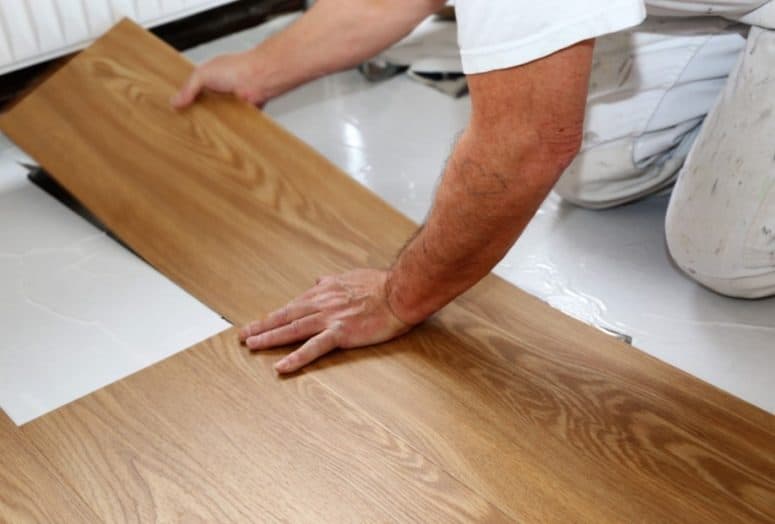
Vinyl, a highly resilient flooring option, enjoys widespread popularity and is primarily composed of Polyvinyl Chloride (PVC).
Certain vinyl flooring types, such as cushioned variants, incorporate a foam layer on the surface, enhancing comfort when stepping on the floor. Vinyl flooring comes in either sheet or plank form. Sheets typically require adhesive for full floor installation, while planks offer options like click-and-stick backing for convenience.
Pros:
- Vinyl exhibits remarkable water resistance and durability, capable of withstanding moisture and resisting scratches, boasting an impressive lifespan of up to 20 years.
- Furthermore, the surface of vinyl can be tailored to resemble wood or stone, providing the appearance of hardwood and a more welcoming, warm sensation underfoot.
- Installation is a breeze with vinyl flooring, and in the event of a damaged plank, you can effortlessly replace it without significant expense. While sheet vinyl may present some challenges, precise measurements can resolve the issue.
Cons:
- While vinyl’s water-resistant properties are commendable, it’s essential to acknowledge that it is composed of PVC, a material that has raised concerns due to its potential harm. In the United States, PVC has been deemed hazardous and banned from use in children’s toys, prompting the need for careful consideration.
- Beyond the material issue, vinyl can sometimes deceive with its appearance. Distinguishing between various qualities of vinyl flooring can be challenging, given the plethora of similar designs mimicking wood or stone.
Linoleum
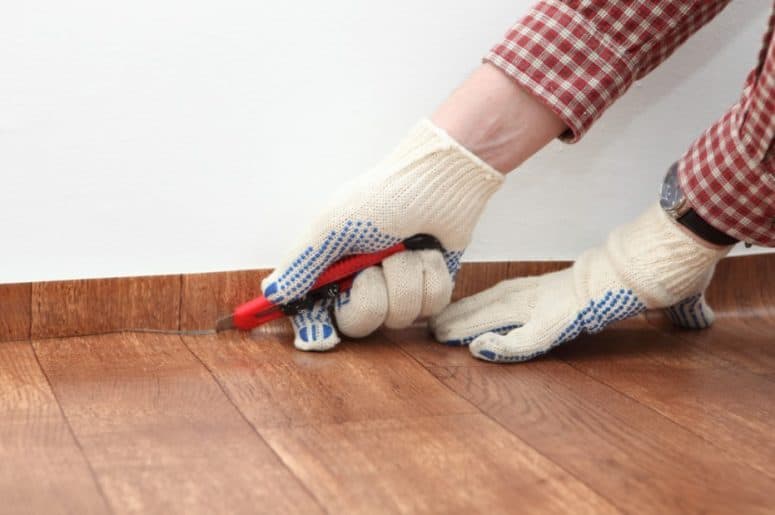
Linoleum flooring, one of the most ancient styles in the world of flooring, distinguishes itself from vinyl by its composition of natural materials, including linseed oil, wood flour, and pigments.
Much like vinyl, linoleum flooring is available in both sheets and planks. However, certain linoleum variations feature protective coatings to safeguard against stains.
Pros:
- Linoleum boasts remarkable durability and resilience, capable of withstanding moisture and heavy foot traffic, making it a suitable choice for high-traffic areas, including kitchens.
- A significant advantage of linoleum is its eco-friendliness. Comprising natural resources, it is biodegradable, recyclable, and environmentally benign.
- Linoleum flooring is impressively long-lasting, with a potential lifespan of up to 40 years, provided proper maintenance is observed. Maintenance is a breeze, requiring simple sweeping and mopping.
Cons:
- However, there are certain considerations when it comes to linoleum flooring. It is less resistant to sharp objects like high heels, which can compromise its water-resistant properties, potentially leading to warping within the layers and accelerated wear and tear. Consequently, it is advisable to install linoleum in bedrooms rather than laundry rooms or bathrooms.
- Linoleum is also sensitive to excessive UV exposure, which can result in staining and fading of its color. Thus, it is better suited for bedrooms and less appropriate for laundry rooms or bathrooms where sunlight exposure is more pronounced.
Cork
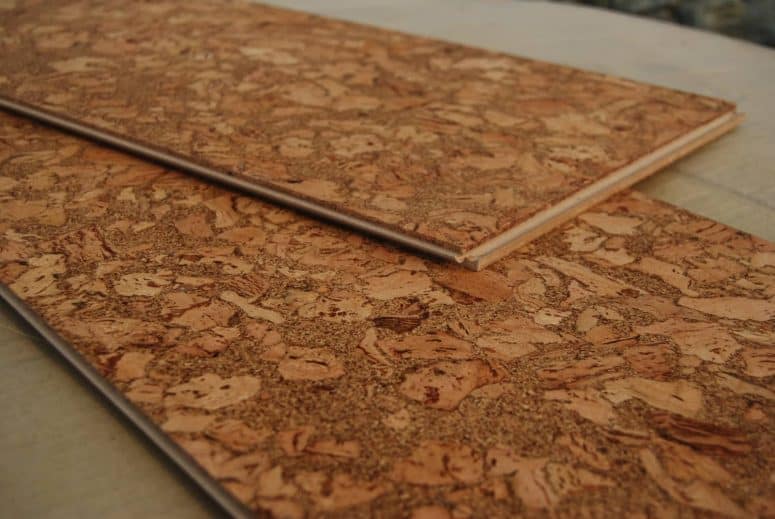
Cork flooring stands out as another popular and resilient flooring option.
The fiberboard constituting cork flooring is crafted by compressing the bark of cork trees, which can be harvested every 8 to 10 years, without necessitating the felling of trees.
This corkboard boasts a top veneer that preserves its natural appearance, featuring the bark of the cork tree on the veneer’s surface.
Pros:
- Cork flooring is widely regarded as one of the most sustainable flooring materials available. It contributes positively to the environment as it involves harvesting cork bark without the need to cut down entire trees, showcasing exemplary eco-friendliness.
- In addition to its natural and appealing appearance, cork flooring does not compromise on safety. It is slip-resistant, making it an excellent choice for areas such as kitchens.
Cons:
- However, it’s essential to note that cork flooring, being a natural material, is sensitive to moisture. Consequently, regular sealing, either with wax or polyurethane, is necessary to prevent stains and damage and maintain its longevity.
Carpet
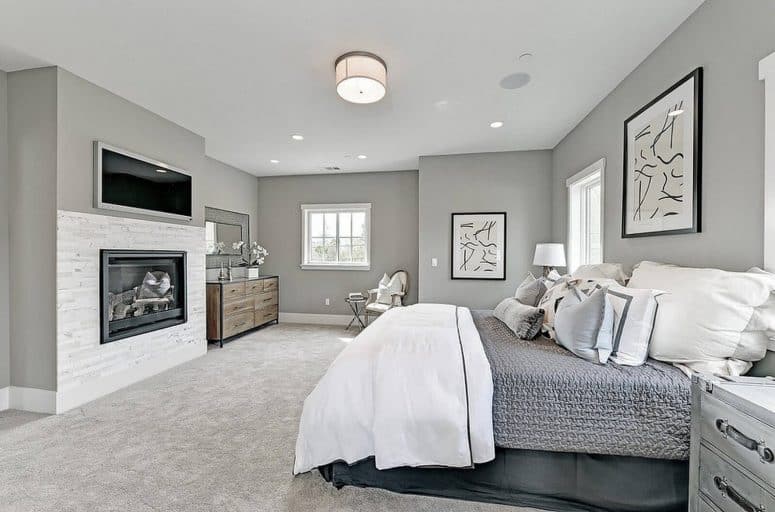
Let’s shift to something a bit softer, shall we? Carpeting ranks among the most prevalent flooring options, composed of an array of delicate fibers that lend themselves well to cozy spaces like bedrooms or living rooms.
Various carpet materials are employed for flooring, including wool, nylon, acrylic, polyester, and polypropylene, each offering distinct characteristics and textures, catering to individual preferences.
Pros:
- The plush feeling underfoot while walking or sitting on carpet flooring is undeniably comfortable and inviting.
- Additionally, carpeting boasts slip-resistant properties and offers durability in terms of installation.
Cons:
- Carpet flooring presents challenges in terms of cleanliness. Vacuuming alone often falls short in effectively removing dirt or restoring the carpet’s original appearance, which typically requires steam cleaning.
- Furthermore, carpet materials have a propensity to trap dirt and microscopic organisms, potentially triggering allergies in certain individuals.
- Neglecting regular cleaning can result in unpleasant odors emanating from the carpet, primarily due to the accumulation of sweat and moisture over time
Natural Stone
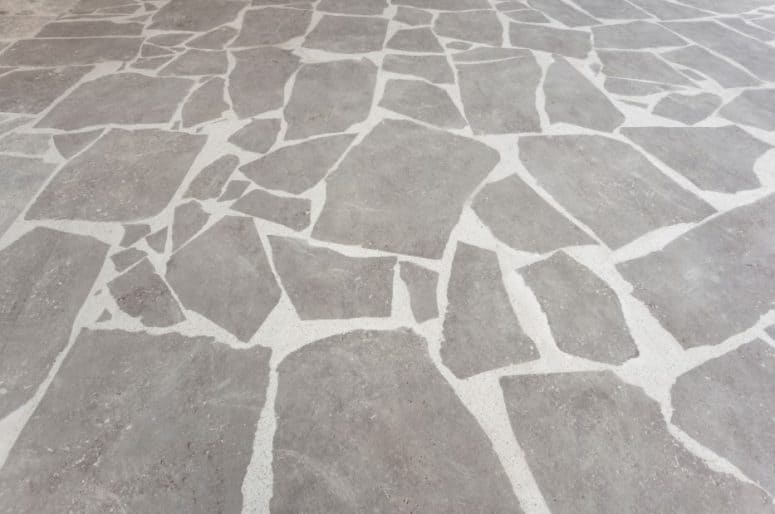
Opting for natural stone flooring is an excellent choice if you aim to infuse rustic charm into your space.
Its captivating abstract patterns and earthy hues make it an ideal selection for both outdoor and indoor decor, provided that you commit to proper maintenance.
People often gravitate toward natural stone for their flooring, lured by its innate beauty and the refreshing ambiance it imparts to a room.
Natural stone flooring is available in various tile sizes, affording you ample options to cater to your preferences.
Pros:
- The standout feature of natural stone flooring is its unparalleled durability, essentially consisting of solid rock. It can withstand moisture, resist scratches, and endure contact with sharp objects.
- The natural appearance and polished surface of natural stone provide a pleasing tactile experience when walking on it.
- Another benefit is that natural stone does not harbor allergens or dust to a significant degree, and it is easy to clean.
- Over the long term, natural stone flooring can augment the value of your home. Consequently, should you decide to sell your property in the future, you can anticipate a favorable selling price.
- The varied shapes and patterns of stone tiles can impart a sense of uniqueness and sophistication to your home decor. This diversity prevents monotony in your interior design, offering stress relief through its abstract, refreshing aesthetic.
Cons:
- One factor discouraging some from choosing natural stone is its challenging installation process. Many individuals opt to enlist the services of a professional contractor to ensure the tiles are expertly and neatly arranged on the floor. The process involves the use of concrete mix to securely affix the tiles, which contributes to the relatively high cost associated with stone tiles compared to other flooring options
Things to Consider When Choosing Flooring
When it comes to selecting the ideal flooring options, several crucial factors demand your attention. These include:
- Room: Not all flooring types are universally suitable. Consider the specific needs of each space. For instance, carpets and hardwood may not be the best choices for every room, so it’s essential to determine which type aligns most harmoniously with your room’s requirements.
- Style: The overall style and aesthetic of your home play a pivotal role in determining the most appropriate flooring type. Some flooring options are better suited than others for achieving the desired visual appeal.
- Budget: Flooring prices vary considerably, often reflecting the quality of the material. It’s vital to establish a budget that aligns with your financial capacity while also considering the long-term durability and value of your chosen floor.
- Family Situation: The presence of young children or pets introduces the potential for spills and scratches. Opting for spill-proof and scratch-resistant flooring can be a wise decision to ensure longevity and ease of maintenance.
- Installation Requirements: Flooring types differ in their installation needs, with some necessitating adhesive or other specialized procedures. It’s crucial to factor in any additional installation costs that may impact your budgetary considerations.
- Return on Investment (ROI): The choice of flooring can significantly influence your home’s value. Higher-quality materials often translate to a more substantial long-term investment. Consider this aspect when making your decision to enhance your property’s overall worth.
Best Flooring Options Room-by-Room
Rooms vary in their requirements, and not all spaces are equal. Some necessitate water-resistant flooring, while others prioritize tranquility and comfort. Consequently, it’s essential to align the choice of flooring material with the specific needs of each room. Presented below are our recommendations for flooring types tailored to individual rooms.
Bedroom
Carpet flooring reigns as the favored option, celebrated for its plush comfort that provides an ideal setting to conclude one’s day and embark on a fresh start. Nevertheless, wood, laminate, and vinyl surfaces also garner preference among certain individuals, catering to diverse tastes and needs.
Kitchen
Vinyl stands as an excellent kitchen flooring choice, given its waterproof nature and effortless maintenance. In a similar vein, tiles and laminate flooring also emerge as desirable options for this space.
Living Room
This room often serves as the initial encounter for guests, shaping their first impressions of your space. Given its relatively low foot traffic, virtually all flooring types are suitable for this area.
Landings/stairs
Staircases experience significant foot traffic, serving as the primary pathway for people moving between different levels of the house. Consequently, it’s essential to ensure a quiet environment. In this context, carpet emerges as one of the preferred options for staircases.
Bathrooms
Rooms prone to high levels of moisture are not suitable for untreated hardwood or carpet flooring. Instead, opt for vinyl, natural stone, or porcelain tiles as they offer water-resistant properties and demand minimal upkeep. Moreover, premium vinyl with an R10 rating enhances safety by providing slip resistance, making it an ideal flooring choice for wet areas.
The Room Where You Allow Pets
Pets are known for their unpredictable actions, which may include scratching, spilling water, and various unforeseen activities. Therefore, it’s advisable to opt for vinyl or laminate flooring in areas accessible to pets, as these materials can withstand scratches and potential contact with sharp objects. Carpet and hardwood flooring, on the other hand, are less suited to such environments, as they are vulnerable to damage from scratches, water spills, and the presence of pet fur.